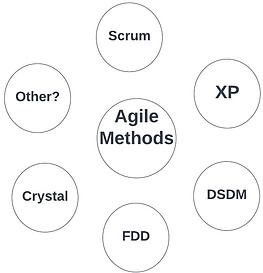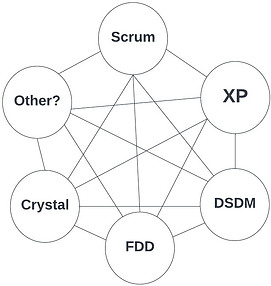Agile is a broad term, and there are many ways to look at it.
From a strategic project management perspective, this post examines some key agile methods and there impact of strategy and project management.
An Agile Methods List Overview
 To provide an initial taste of agile methods, consider the following list:
To provide an initial taste of agile methods, consider the following list:
- Scrum – Scrum codifies the ‘pillars and values’ of transparency, inspection, and adaptation. This is most visibly implemented in sprints, with well-established scrum team roles. The sprint cycle includes key ‘ceremonies’: sprint planning, daily scrum, sprint review, and sprint retrospective. The team returns to the ‘sprint backlog’ to do it all over again in the next sprint.
- Extreme Programming (XP) – XP is focused on software development – but that does not mean it cannot be applied elsewhere! There are specific values – simplicity, communications, feedback, courage, and respect – that map pretty closely to the Agile Manifesto. Team roles – coach, customer, programmers, testers – are also similar to what you find in scrum. A coach, for example, is akin to the scrum master, and customer is similar to product owner.
- Dynamic Systems Development Method (DSDM) – DSDM has agile values at its foundation, and is broadly focused on development life cycle. That life cycle starts with the business case and determining feasibility. It then iterates through functional models, and then design and build. The deliverable is implemented, and the next iteration starts again with feasibility and business drivers.
- Feature Driven Development (FDD) – FDD involves identifying an overall conceptual model, building a feature list, and planning development around those features. Development is then done in sprints through selection of features for the sprints and performing and design and build within each sprint. Feature sets are developed by focused teams – there is no built-in cross training and overall ownership.
- Crystal – Crystal provides a framework for a ‘family’ of customizable methods, primarily along two dimensions. One dimension is team size. Crystal has individualized, color-coded methods based on team size, from small (1-6) to large (101-200). The other dimension is criticality. Crystal defines criticality along a continuum from feeling uncomfortable at the lowest level, effecting funding at the mid-level, to being life-threatening at the highest level.
Are there more agile methods? These are the most popular over time, but I like to leave the door open to new approaches and innovations.
Applicability of Each Agile Method
 The agile methods described are primarily focused on software development. However, there are things we can learn from them that can be applied elsewhere. This section explores some ideas for how they can be applied in different situations.
The agile methods described are primarily focused on software development. However, there are things we can learn from them that can be applied elsewhere. This section explores some ideas for how they can be applied in different situations.
The focus is on thinking about product development of any type, in any industry.
- Scrum – Think about product development. In most industries, it is an iterative process on some level. The beauty of scrum is that it sets a cadence that plays right into the idea of delivering early and often – to fail fast and eventually move forward with a product that will work and fill a customer need.
- Extreme Programming (XP) – This is the digital age, and very few products come without a digital component. Some concepts of XP can be used for developing those digital components – and for integrating those components into the overall product deliverable.
- Dynamic Systems Development Method (DSDM) – The beauty of DSDM is first in the idea of always keeping in mind the business drivers. DSDM keeps the team coming back for a refresh on business case and feasibility. It goes further with each cycle to isolate the iterative work of getting something done – like delivering something efficiently at each iteration.
- Feature Driven Development (FDD) – There may be instances where it is beneficial to ‘divide and conquer’ – to organize the team around specific sub-efforts. There may be something lost in terms of cross-training and cross-pollination, but you also may be able to focus and find ways around that.
- Crystal – The unique contribution of Crystal is the acknowledgment of the need for a customized approach for each project or situation. What is the size of the team? That will have a great impact on the organizational approach. What are the risks? Again, the approach needs to be tailored to effectively manage the level of risk involved.
The idea here is to learn something from these various methods that provides a reservoir of resources to be accessed when approaching a fresh new situation.
Implications for Strategy
I like the strategic approach right out of the Jay Abraham playbook. Jay has always pushed learning as much as possible about different industries – and taking good ideas and best practices from one industry and transplanting them in your company. This is a way to differentiate and out compete.
Similarly, like practices from different industries, practices from different methodologies and approaches can be mixed and matched. This creates a new kind of unique offering and strategic advantage.
That is somewhat the approach with Crystal, for example. Crystal acknowledges the need for custom approaches to match the situation.
For example, say you have a situation where you have an Internet of Things (IoT) project. What about taking a Crystal approach…and combining it with FDD, where you would organize the team around certain specific initiatives.
Or, if the project is smaller, what about mixing in some XP where everyone commonly owns the code and commonly shared responsibility for the development?
What about mixing in a bit of Scrum to make the development more agile. In the case of IoT, you have a mix of physical and virtual product. Use Scrum for both! Make development of both the physical and virtual sides as iterative as possible.
In all cases, it is best to keep the business drivers firmly in mind, as is embedded in DSDM.
The idea here is to borrow, mix, and match from the different methodologies and approaches to come up with something that best fits the situation. It takes an ‘experimental’ mindset to do so. Having that experimental mindset can be your key strategic advantage.
—————————————-
I recommend these strategy resources (paid link):
—————————————-
Implications for Project Management
Much of what I suggested in the ‘Strategic Impact’ section above could just as well apply to project management. Here strategy and project management are melting together.
Isn’t that the way it happens in a startup? The lines between project management and strategy are blurred. There is a lot of trial and error – a combo of strategic thinking and rapid implementation.
It needs to be done rapidly!
That’s the whole idea of agile – to deliver early and often, and to be open to pivots as you learn.
The 7th Edition of the PMBOK (Project Management Body of Knowledge) Guide, the most recent, is much less prescriptive and much more inclusive of lots of different approaches. The idea, I believe, was to codify that mixing and matching approaches is good. Being aware of lots of approaches, therefore is helpful to PM’s in determining the unique mix to tools and methods – a hybrid approach – that can best produce a successful project.
—————————————-
I recommend these PM templates (paid link):

—————————————-
Conclusion
This post examined some key agile methods and how they can be leveraged for strategic gain and effective project management.
What agile methods have use used, and what have been your results?
The following video provides some good complementary thinking on agile methods:
